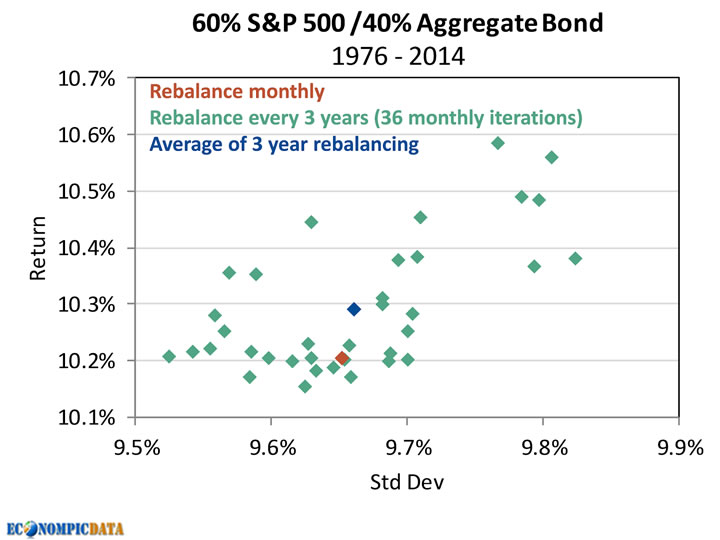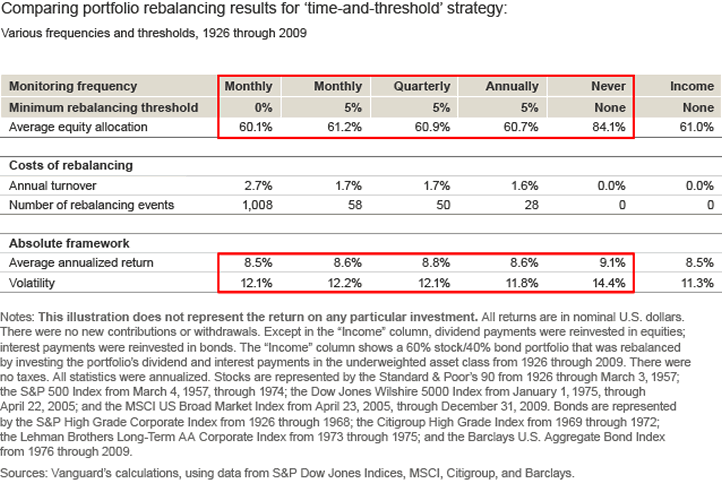 Here’s another data point on the debate on how often to rebalance your portfolio to your target asset allocation. Econompic Data writes about rebalancing a portfolio back to 60% S&P 500 / 40% Barclays Aggregate Bond index from 1976-2014 and finds that rebalancing every 3 years actually produced slightly better average annual returns that rebalancing monthly (via Abnormal Returns):
Here’s another data point on the debate on how often to rebalance your portfolio to your target asset allocation. Econompic Data writes about rebalancing a portfolio back to 60% S&P 500 / 40% Barclays Aggregate Bond index from 1976-2014 and finds that rebalancing every 3 years actually produced slightly better average annual returns that rebalancing monthly (via Abnormal Returns):

Momentum is cited as a potential reason why this works. Looks good at a glance, but look at that y-axis. We are comparing 10.3% and 10.2%. Is that really significant?
I would point out that in a previous Vanguard research article, a similar backtest was done on a 60/40 Broad US Stock/Broad US Bond portfolio rebalanced across various thresholds from 1926-2009. Their conclusion (emphasis mine):
We found that no one approach produced significantly superior results over another. However, all strategies resulted in more favorable risk-adjusted portfolio returns when compared with returns for portfolios that were never rebalanced.

From a 2008 paper from Dimensional Fund Advisors:
Aside from avoiding excessive trading, there are no optimal rebalancing rules that will yield the highest returns on all portfolios and in every period.
From advisor and author William Bernstein:
The returns differences among various rebalancing strategies are quite small in the long run.
Instead of there being a benefit to rebalancing less often, it may just be safer that the frequency doesn’t matter. On the other hand, given the potential cost of rebalancing from taxes, commissions, and bid/ask spreads perhaps lowering the frequency doesn’t hurt.
I think the most important thing to note is that in every test case above, the rebalancing was done on a strict schedule and without emotion. The problem you are really trying to avoid is being afraid buy whatever has been getting crushed and selling what has been doing awesome. There’s that behavioral/emotional component again.
As for me, I try to check my portfolio once a quarter, but rebalance no more than once a year. An annual frequency is as easy to remember as your birthday, it’s not too often and not too seldom, lots of smart people are proponents, and it gives me the opportunity to do tax-loss harvesting. I use tolerance bands such that if my major asset classes are off by more than 5%, then I will rebalance. Otherwise, I “rebalance lite” year-round using any new money to buy underweight asset classes.
 The Best Credit Card Bonus Offers – 2025
The Best Credit Card Bonus Offers – 2025 Big List of Free Stocks from Brokerage Apps
Big List of Free Stocks from Brokerage Apps Best Interest Rates on Cash - 2025
Best Interest Rates on Cash - 2025 Free Credit Scores x 3 + Free Credit Monitoring
Free Credit Scores x 3 + Free Credit Monitoring Best No Fee 0% APR Balance Transfer Offers
Best No Fee 0% APR Balance Transfer Offers Little-Known Cellular Data Plans That Can Save Big Money
Little-Known Cellular Data Plans That Can Save Big Money How To Haggle Your Cable or Direct TV Bill
How To Haggle Your Cable or Direct TV Bill Big List of Free Consumer Data Reports (Credit, Rent, Work)
Big List of Free Consumer Data Reports (Credit, Rent, Work)
what are thoughts on using s target date fund to keep your investmentments balanced?
No thoughts or opinions?
I have to admit I’ve never really seriously considered one myself. My wife had one in her 403B plan at a previous employer. Although its returns were decent, I found it to be too conservative (we’re both age 54; the fund had about a 60% stock/40% fixed allocation). I guess I don’t like the idea of turning over the decision making for adjusting my asset allocation over time to a fund manager. Also, I have a concern that these types of funds create an impression among many investors — and are marketed as such — that they will produce a nice big pot of money at retirement with little risk involved.
I write about Vanguard Target Retirement funds pretty often, and I think they are a good option and do all the rebalancing for you (I forget the frequency). I’m not as big a fan as the other major target funds, I would say 2nd place goes to T Rowe Price.
https://www.mymoneyblog.com/vanguard-target-retirement-fund-changes-2015.html
https://www.mymoneyblog.com/vanguard-target-retirement-funds-underrated.html
Thanks Jon. vanguard is the best of the big investment firms, all of my money is with a Fidelity but I’d love to get my employer to move their 401k program to vanguard.
To make investment balance more agressive, I add 20 years to my actual plan retirement date when choosing the target date fund. That way I get the benefit of automatic rebalancing and the agressiveness that I desire as well.
I used to use the 3 fund portfolio from bogleheads, but I found that the return on investment for the time I spent rebalancing things myself was negative . So I decided to let someone else do it while I focused on making more money. It’s working out a lot better that way. ( for me)
Great timing on this post — I was looking at my 401k automatic rebalancing options just last night, and I personally decided to automate my rebalancing to semi-annually. The automatic options are making this a no-brainer to keep up with — I believe this particular 401k company allows rebalancing to be indefinite or scheduled for a certain timeframe, and ranges in options from weekly (!!) to annually.
Wish that my company offered Vanguard for 401ks, as my current provider has some relatively high fees on the respective funds, but…
So what is benefit of rebalancing? Stocks have high expected returns, while fixed income has low expected returns. Over time, you are subtracting return from your total portfolio, since you will be continuously selling stocks to buy fixed income. All of this is done so that the investor does not get scared when things get tough. So isn’t that /60/40 portfolio in effect promoting behavior biases in itself?
I would say it’s a personal thing, related to one’s risk tolerance — or aversion — that is being able to sleep at night regardless of the what the market is doing. Some of course are content with a 100% stock portfolio and look at steep downturns as a buying opportunity. That was my perspective for many years. But as early retirement has actually started to become a real possibility visible on the horizon, I’ve shifted to an approximate 80% stock/20% fixed income portfolio — and do find myself having more of a concern of being able to ride out volatile market swings once that day comes that I no longer have any employment income.
The goal is highest risk-adjusted returns. That why people diversify into multiple asset classes, otherwise you’d just own the highest returning one regarding of risk.
As long as you are ok with holding more stocks than preferred, it seems like rebalancing less often is a fine idea. I’ve been trying to use the 5/25 rule which allows for a good amount of change in asset allocation before needing to rebalance.
+1
Using Larry Swedroe’s 5/25 rule as well. I have not analyzed how effective that is compared to annual rebalancing; but the rule results in me rebalancing every 3-4 years anyway.
Also, when I contribute new money, I sort of end up rebalancing since I put money where necessary.
Did they look at doing it every 2 years?
I’d wonder if this better result for doing it every 3 years was just coincidence or random chance.
Hey Jonathan,
I rebalance when any of my allocations drift 25% from their original spot.
For example: Let’s say I hold 10% of my portfolio in a certain ETF.
If it drifts 25% in either way, either two 12.5% or 7.5%, it’s time to rebalance.
I rarely have to rebalance annually, and even then, it’s usually only between two or three investments.
I personally love how Betterment deals with rebalancing: any new money invested is distributed based on which funds are below allocation target. Same for dividends. Only when your portfolio drifted more than 5%, they will go ahead and start selling the funds over target. And they will always make sure to minimize taxes doing so (selling long term positions before short term for example).
If you exclude transactions costs (none for Betterment), I wonder why rebalancing super frequently does not yield better results…wouldn’t that mean that you would constantly sell high and buy low which is at the end of the day what is desired?
Because you are selling when an asset class has momentum. You very well could be buying back in after it increases even more.
The issue with high frequency rebalancing could be the bid-to-ask spread. Betterment claims they only invest in very liquid funds, meaning the spread would be smaller, about 2-4bps. This could add up to a substantial amount of money if the automatic rebalance occurs too often.
If you are going to rebalance your portfolio every year or so, you are better off waiting at least 366 days so as to get the long term gains. provided that there are gains involved.
I like the term “Rebalance Light” that you’ve coined! I’ve found that implementing Rebalance Light with new money together with Swedroe’s 25/5 rebalancing bands at my current portfolio balance usually seems to take away the need to “non-light” rebalance unless there’s a major correction or something.